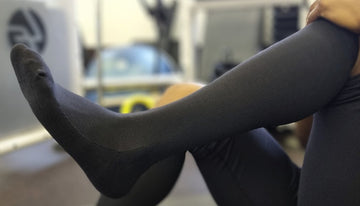Compression Socks for Beginners: A Simple How-To Guide
by Emily Jannet on Jun 14, 2024
While compression socks are great for boosting circulation and reducing leg swelling, many people struggle with the challenge of putting them on. These socks fit tightly to provide the necessary pressure, which can make them tricky to don. Whether you need them for better athletic performance, long flights, or medical purposes, knowing the right technique to wear compression socks can improve both their comfort and effectiveness. In this guide, you’ll learn straightforward steps to easily and properly wear your compression socks.
Why Wear Compression Socks?
Before diving into the how-to, it’s important to understand why you might wear compression socks. These socks apply gentle pressure to your legs, promoting blood flow from your legs back toward your heart. Benefits include:
Reduced Swelling: Helps prevent and reduce swelling in your legs and ankles.
Enhanced Circulation: Improves blood flow, which can be beneficial for those with circulatory issues.
Increased Comfort: Eases discomfort from standing or sitting for prolonged periods.
Prevention of Deep Vein Thrombosis (DVT): Helps prevent blood clots, particularly during long flights or car trips.
Choosing the Right Compression Socks
Before you can put on compression socks, ensure you have the correct pair for your needs. Compression levels are measured in millimeters of mercury (mmHg), with different levels providing varying degrees of pressure. Consult with a healthcare provider to determine the best level of compression for you.
Steps to Put On Compression Socks
Putting on compression socks might seem daunting due to their snug fit, but following these steps can make the process much simpler.
Step 1: Prepare the Socks
Start by turning the sock inside out, at least partially. This technique helps position your foot more easily and reduces the effort needed to pull the sock up.
Hold the sock at the heel: Place your hand inside the sock and grab the heel pocket.
Invert the sock: Pull the top of the sock down to the heel, effectively turning the foot section inside out.
Step 2: Position Your Foot
Sit down on a comfortable chair and place your foot through the opening of the sock. Make sure your toes and the ball of your foot are positioned correctly within the foot of the sock.
Slide your foot in: Carefully slide your foot into the sock until your toes reach the end.
Adjust the heel: Ensure the heel of the sock aligns with your own heel. This alignment is crucial for proper compression and comfort.
Step 3: Pull Up the Sock
With your foot correctly positioned, begin pulling the sock up your leg. This step requires a bit of patience and gentle tugging.
Work gradually: Slowly roll the sock up your ankle and calf. Avoid pulling too hard as this can overstretch the fabric.
Smooth out wrinkles: As you pull the sock up, smooth out any wrinkles or folds. Wrinkles can cause discomfort and reduce the effectiveness of the compression.
Step 4: Adjust for Comfort
Once the sock is fully on, make final adjustments to ensure it's comfortable and correctly positioned.
Check the fit: The sock should be snug but not excessively tight. Ensure the top band sits flat against your skin without rolling down.
Reposition if necessary: If you feel any discomfort or notice the sock is uneven, carefully adjust its position until it feels right.
Tips for Easier Application
Use Rubber Gloves: Wearing rubber gloves can provide a better grip on the fabric, making it easier to pull the socks up.
Apply Lotion: A small amount of lotion or baby powder on your legs can help the socks slide on more smoothly. Make sure your skin is dry before putting the socks on.
Use a Stocking Donner: This device can assist in putting on compression socks, especially if you have limited mobility or strength in your hands.
Morning Application: Try putting on your socks in the morning when your legs are less swollen.
Caring for Your Compression Socks
Proper care of your compression socks will extend their lifespan and maintain their effectiveness.
Wash Regularly: Hand wash or machine wash on a gentle cycle with mild detergent. Avoid bleach and fabric softeners.
Air Dry: Lay flat to dry or hang them up. Avoid using a dryer as the heat can damage the elastic fibers.
Inspect for Wear and Tear: Regularly check your socks for signs of wear, such as thinning fabric or reduced elasticity, and replace them as needed.
Putting on compression socks may seem tricky at first, but with a little practice and the right techniques, it becomes much easier. These steps ensure that you can comfortably and effectively wear your compression socks, reaping the full benefits they offer. Whether you’re using them for medical reasons, during pregnancy, for athletic performance, or simply to reduce swelling, proper application is key to maximizing their effectiveness. Remember to consult with your healthcare provider to determine the appropriate compression level and style for your needs.





